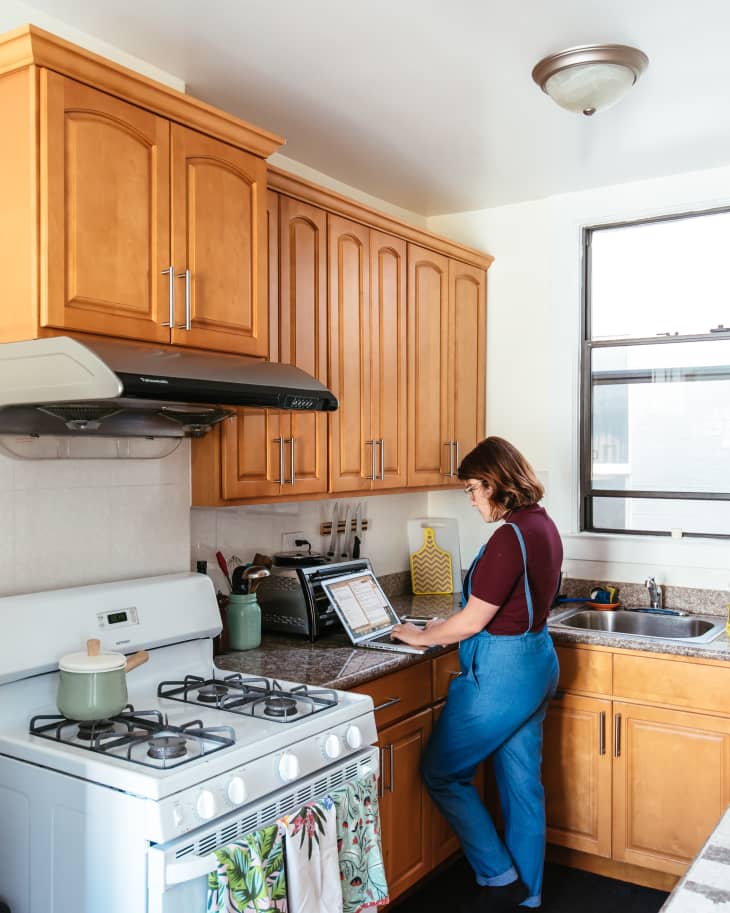How Cutting My Food Budget Helped Me Quit My Full-Time Job
In early 2015 I was single, lived alone in Boston, MA, and spent more than $500 a month on food and alcohol. I had visions of quitting my full-time job to travel and pursue a career in freelance writing, but first I had to address my serious spending problem. After a bad day at work I came home and compiled a spreadsheet with self-imposed grocery guidelines.
Before the budget, a typical lunch was a Greek takeout salad ($12) followed by a midday Grande black iced tea at Starbucks ($2.50). After spin class I’d stop at Whole Foods for dinner, picking up a piece of pre-cooked salmon or a helping at the hot food bar ($10 to 15). Perhaps I’d throw a chunk of cheese ($5) and a container of olives ($6) in the cart, too, along with a single-serve seltzer ($1.25) for the car ride home. That’s in addition to my weekly shopping trip, which was a mish-mash of anything that looked good ($80 to $100).
Here’s how I slashed food spending to under $200 a month so I could quit my job and travel and write for a living.
6 Ways I Keep My Food Budget in Check
1. I create a meal plan.
I adhere to a weekly theme instead of specific dishes. Some weeks are Mediterranean or Indian, while others are all about sandwiches. A Mediterranean week includes Greek olives, feta or Italian cheeses, pasta, and veggies. Spaghetti with olive oil and spinach are a favorite dinner, and I use leftovers for spaghetti pie. That week’s lunches might include Niçoise salad or a big pile of veggies stuffed into a pita with freshly made dressing. An Indian week is a feast of cauliflower, potatoes, eggplant, chicken, rice or naan, and a bottle of red curry sauce.
2. I buy less food.
This seems obvious, but previous to meal planning I bought more food than I could eat, and a good portion went to waste. The problem? I loaded up on too many similar foods, like multiple types of bread, cheese, meats, and desserts.
Now sandwich week means English muffins, not English muffins, tortillas, and a loaf of olive bread. Generally I give myself a one-per-category limit. (If you ever walk through Trader Joe’s in the Boston area and see a woman holding a package of chocolates in one hand and a pint of cookie butter ice cream in the other, asking herself, “Which one do I really want because I can’t have both?” — that’s me.
3. I eat seasonally.
Eating seasonally is good for a lot of reasons, one of them being that it’s kind to your wallet. I would previously shell out $6 for a pint of blueberries or strawberries in January to mix in my daily oatmeal. Now I save fresh berries for summer months when their taste pops and a container can be found for $2.
4. I cut back on meat.
Don’t shun the “V” word — ahem, vegetarian. Beans and eggs are a fraction of the cost of even cheap cuts of meat. While the trend is catching on with efforts such as Meatless Monday, I took my cues from my Italian-American grandparent who took their cues from an old-school, Roman Catholic tradition of abstaining from meat on Wednesdays and Fridays. Their pasta e fagioli made with chickpeas, escarole, and ditalini pasta became my pot of white beans, spinach, and fusilli. Omelets with veggies, and an egg and potato scramble (my ode to the Spanish tortilla de patatas) are also favorites.
Get inspired: 10 Budget-Friendly Dinners for Meatless Monday
5. I shop local and buy generic.
This made the biggest impact on the budget. Switching from a large national chain to rotating between Market Basket, a Massachusetts retailer, and Trader Joe’s, reduced my weekly bill 20 to 30 percent compared to shopping elsewhere. Goofy packaging aside, most generics are just as good as the original.
A sampling of store-brand prices from Market Basket in Somerville, MA
- 12-pack of seltzer (a knock-off of LaCroix, but just as tasty), $2.50
- 2 cans of imported tuna in olive oil, $4
- 8-ounce package of New York sharp cheddar (this is a favorite and more flavorful than higher-end brands), $2
- 1-pound bag of lemons, $2.49
A sampling of prices from Trader Joe’s in Cambridge, MA
- 5.3-ounce container of Greek yogurt, $0.99
- 8-count package of corn & wheat tortillas, $1.99
- 15-ounce can organic black beans, $0.99
- 6-count bag of “teeny tiny” avocados, $2.99
6. I still go out, but drink less.
I didn’t want to completely abstain from meeting friends for dinner or drinks, especially when I was cutting back on everything else in my life. Unfortunately, $12 to $15 cocktails are the norm in Boston. To stay within budget I gave myself a one-cocktail-a-week limit. In addition, we added BYOB restaurants to our roster, cutting an average dinner bill by at least $20.
The Results of My Budgeting
How did it work out? I met my savings goal in just under two years. In full transparency I moved in with a roommate for one year ($600/month savings for 12 months). I also stopped grocery shopping about a month before giving notice. I’m pretty certain coworkers thought I was knee deep in gambling or drug debt because more than once they caught me in the office kitchen eating questionable leftovers or nibbling on the last of a mangled banana instead of chipping in for a group lunch. But hey! It was totally worth it.
